By Mike Smith
This training session is a functional tactical approach that emphasizes that we must have clarity on our roles. For this session, seven and eleven must stay wide when ball is down the middle of field. When ball moves to flank, the near side player must stay wide and the far side needs to drift in. When the ball comes down the middle of the field we must find the flank quickly and then maintain possession in the front third with composure. It does not need to go into the box immediately. Long direct balls should work hard to find the central forward number nine player. The ball should not just be banged to the forward every play. Balls driven too far are better than balls not driven far enough. If the nine feels a guy tight on his back, try to hold and turn the guy. If the person is tight and drops off, send the ball back to the CM. Flat four need to work together.
Lesson 1: Warm-up: Build Up
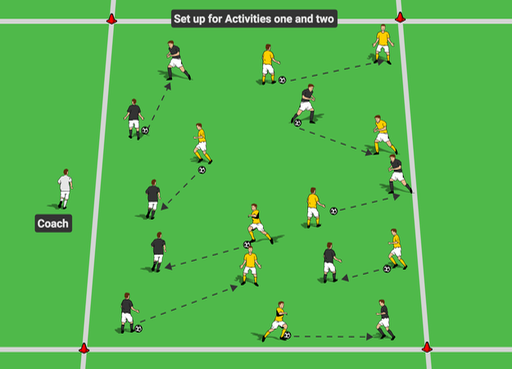
Setup:
Warming up our players often happens separate from the actual skills of soccer and is viewed by many coaches as unrelated to the theme of training in the main series.
This activity emphasizes a gradual warm up using the skills that will be needed during the main series when working on passing and receiving and possession skills. The activities described should be intermittent with range of motion and active stretching when transitioning from one step to another in the described activities. All stretching should last at least one minute per stretch with any static stretching. Coaches must lead the stretch so that the duration of the stretch is not cut short. Each of the activities described can last around 3-4 minutes for a long gradual warm-up leading toward a main series workout.
All players should have vests at the start of this activity and split into two different color groups. For this activity they will be described as wearing yellow or black.
Execution:
Activity 1: Players are grouped into twos while passing and receiving with their designated partner in the grid space provided (for groups of 18 or more the grid should be quite large to encourage lots of movement covering all portions of the grid). Give instruction to keep the head up and avoid touching any other players.
STRETCH INTERVAL FOLLOWS
Activity 2: Play continues with one ball per two people but instead of a designated partner, the players with the ball must find any person in the grid and pass to the person who actively calls for the ball. Players must not pass the ball to anyone who does not actively show for the ball by communicating their desire for the ball through their voice, their posture or clear eye contact. Coach must emphasize those three methods of communication.
STRETCH INTERVAL FOLLOWS
Activity 3: Players continue play but yellow may only pass and receive with yellow and black may only pass and receive with black. This will force player's to think ahead and pick out their "team" in the midst of the chaos of the ball movements and player movements.
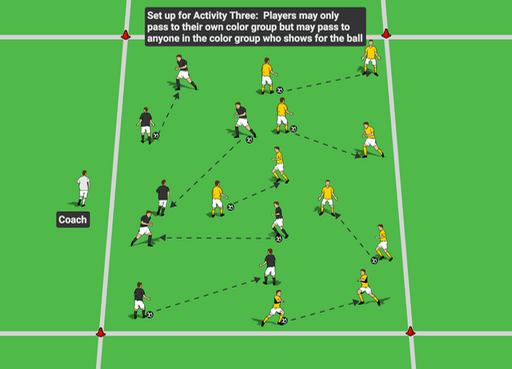
STRETCH INTERVAL FOLLOWS
Activity 4: All players remove their vests and tuck them into their waist bands. Reduce the number of balls for passing and receiving and restart the activity with passing and receiving to anyone in the grid (same restriction on passing only after appropriate communication as earlier). As coach determines he/she instructs a player to put on his or her vest and that player then becomes a defender who seeks to intercept passes and knock the ball out of the grid. Balls knocked out of the grid can be retrieved by a player and then resume the passing and receiving. Coach adds the number of defenders based on preference and desire for pressure on the warm-up. Coach may also reduce the number of balls allowed for passing and receiving.
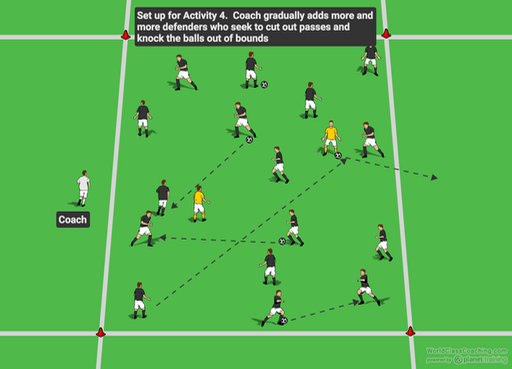
STRETCH INTERVAL FOLLOWS
Activity 5: Coach reduces the number of balls to three for passing and receiving. As the number of players builds up the defending players with vests on no longer attempt to knock the ball out of play but instead try to keep possession inside the grid. The other players attempt to win the ball back for their passing and receiving with non-vest wearing players. It basically becomes a game of keep away.
STRETCH INTERVAL FOLLOWS
Activity 6: Coach controls the numbers leading to even sided play with both teams attempting to maintain possession. The coach closely monitors play and challenges each team to attempt to possess all three balls at the same time. When one team possesses all three of the balls then play is stopped and the losing team makes a sprint to the end line and back. Then play is resumed with the same challenge until the coach calls conclusion of the warm-up.
Comment
Coaches focus on raising intensity as time passes. Control number of balls as well. Select initial players to defend that will raise intensity of play.
Lesson Two: Multi 3 v 3
Setup:
Players are divided into groups of three. Field sizes are 20 by 25. Series of fields in a row. Most fields with small goals and two fields with full goals and keepers.
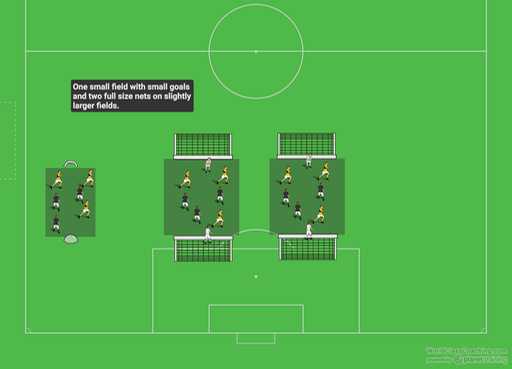
Execution:
Players stay in groups and move up the line based on wins or color rotation.
Lesson Three: Attack V Defense - Phase of play transition
Setup:
The teams are set up as shown with four black attackers vs. four yellow defenders. The red team is lined up on the outside of the field.
Execution:
Teams play four vs. four in the space. The black team attacks the mini goals and the yellow team attacks the full sided goal. The red team is played in by either team but cannot participate until played into by one of the teams in possession. Once possession is lost by either team the red team drops back off until played in again by one of the teams. Rotate teams for defending the full size goals and rotate the red team in to the possession roles as well.
Variations:
Coach can restart every ball
Goal keeper can restart every ball
Outside team rotates in after every goal or every two goals
Always play make it take it
Coaching points:
1. Delay, Deny, Dictate space when defending
2. Create, exploit, space when attacking
2. Communication between players essential, who has what roles?
3. Quick transition when winning/losing the ball
4. Correct weight of pass
5. Accurate shots
Lesson Four: Progression to Full Sided Play (Functional Tactical Play)
Coach should add numbers starting with a 6 v 4 concentrating on first pass to attacking number 9 player. Move toward 8 v 5 and 8 v 6 by adding a defensive mid to the defensive side. Play continues as it moves to full sided play. Once full sided the coach continues to dictate the delivery of the first ball. Coach may demand that the ball is played to number nine first each play. Or coach may demand that play starts with the defensive mid dribble penetrating to emphasize wide play out of seven and eleven. A final control is coach demands the ball start on the flank with the OB requiring the near side 7 to play wide and the far side 11 to pull inward and forward.
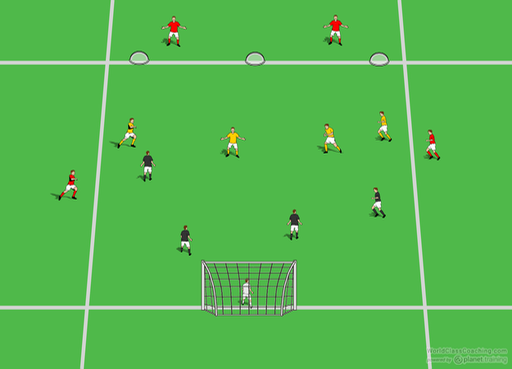
Full sided play
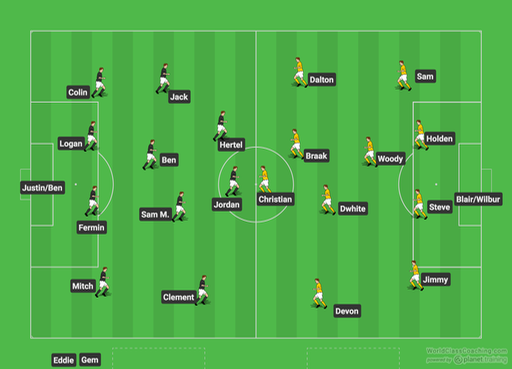
Setup:
Groups of 11 vs. 11
Execution:
Full field. Coaches randomly end play with whistle and start a new ball where the coach desires to work on functional play.
Variations:
Move players as needed and subs.
By Mike Smith
Currently the Head Coach for University Heights Academy Boys Soccer in Hopkinsville, KY , Mike is in his 14th year as a high school head coach with 23 years coaching experience overall and 34 year as a student and fan of the game. He holds a USSF D License.


